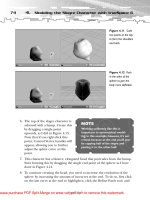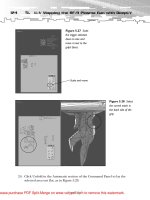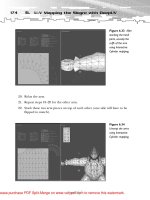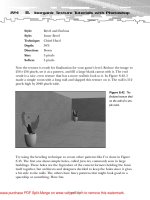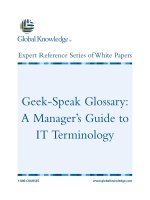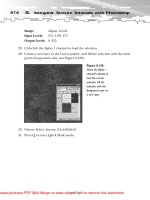Beginning Blender: Open Source 3D Modeling, Animation, and Game Design docx
Bạn đang xem bản rút gọn của tài liệu. Xem và tải ngay bản đầy đủ của tài liệu tại đây (16.98 MB, 449 trang )
CYAN
MAGENTA
YELLOW
BLACK
PANTONE 123 C
THE EXPERT’S VOICE ® IN OPEN SOURCE
BOOKS FOR PROFESSIONALS BY PROFESSIONALS ®
Companion
eBook Available
Beginning Blender:
Dear Reader,
In Beginning Blender I will introduce you to the world of 3D starting with the
basic essentials to get you successfully creating your own models, and then
moving on to more advanced techniques with each chapter. This book includes
information on how you can use Blender to make your own 3D masterpiece
from nothing but the ideas in your head.
Lance Flavell
You will learn
•How to create models using sculpting, extrusion, and more.
•How to texture your models to create exciting effects.
•How to light your scenes to show them off at their best.
•How to rig a character you have made for animation.
•How to use the compositor for movie mixing and lip-syncing animations.
•How to harness advanced techniques such as physics simulation, including
computer generated hair, fluid, and particles.
•How to go about making your own computer games.
Beginning
Blender
Open Source 3D Modeling, Animation,
and Game Design
Full Color Inside
Every chapter of Beginning Blender is jam-packed with illustrations and step by
step instructions. This book is designed to be a both a series of tutorials and a
reference you will keep coming back to; with it you can begin working on your
own 3D movies and animations, or even your own 3D computer games. The
only limit is your imagination.
Beginning
Blender
Open Source 3D Modeling, Animation,
and Game
Lance Flavell (Bachelor of Arts, Diploma of Teaching, Diploma of 3D Animation)
Design
Companion eBook
Learn everything you need to know to create
your own 3D design and animation projects
See last page for details
on $10 eBook version
Full Color Inside
SOURCE CODE ONLINE
US $49.99
ISBN 978-1-4302-3216-2
5 49 9 9
Flavell
www.apress.com
Lance Flavell
Shelve in:
Graphics/General
User level:
Beginning–Intermediate
9 7814
30 232162
www.it-ebooks.info
this print for content only—size & color not accurate
trim = 7" x 9.125" spine = 0.96875" 432 page count
www.it-ebooks.info
Beginning Blender
Open Source 3D Modeling, Animation,
and Game Design
■■■
Lance Flavell
i
www.it-ebooks.info
Beginning Blender: Open Source 3D Modeling, Animation, and Game Design
Copyright © 2010 by Lance Flavell
All rights reserved. No part of this work may be reproduced or transmitted in any form or by any means,
electronic or mechanical, including photocopying, recording, or by any information storage or retrieval
system, without the prior written permission of the copyright owner and the publisher.
ISBN-13 (pbk): 978-1-4302-3126-4
ISBN-13 (electronic): 978-1-4302-3127-1
Printed and bound in the United States of America 9 8 7 6 5 4 3 2 1
Trademarked names, logos, and images may appear in this book. Rather than use a trademark symbol with
every occurrence of a trademarked name, logo, or image we use the names, logos, and images only in an
editorial fashion and to the benefit of the trademark owner, with no intention of infringement of the
trademark.
The use in this publication of trade names, trademarks, service marks, and similar terms, even if they are
not identified as such, is not to be taken as an expression of opinion as to whether or not they are subject to
proprietary rights.
President and Publisher: Paul Manning
Lead Editor: Frank Pohlmann
Technical Reviewer: Luca Bonavita
Editorial Board: Steve Anglin, Mark Beckner, Ewan Buckingham, Gary Cornell, Jonathan Gennick,
Jonathan Hassell, Michelle Lowman, Matthew Moodie, Duncan Parkes, Jeffrey Pepper, Frank
Pohlmann, Douglas Pundick, Ben Renow-Clarke, Dominic Shakeshaft, Matt Wade, Tom Welsh
Coordinating Editor: Tracy Brown
Copy Editor: Damon Larson
Compositor: MacPS, LLC
Indexer: Potomac Indexing, LLC
Artist: April Milne
Cover Designer: Anna Ishchenko
Distributed to the book trade worldwide by Springer Science+Business Media, LLC., 233 Spring Street, 6th
Floor, New York, NY 10013. Phone 1-800-SPRINGER, fax (201) 348-4505, e-mail , or visit www.springeronline.com.
For information on translations, please e-mail , or visit www.apress.com.
Apress and friends of ED books may be purchased in bulk for academic, corporate, or promotional use.
eBook versions and licenses are also available for most titles. For more information, reference our Special
Bulk Sales–eBook Licensing web page at www.apress.com/info/bulksales.
The information in this book is distributed on an “as is” basis, without warranty. Although every precaution
has been taken in the preparation of this work, neither the author(s) nor Apress shall have any liability to
any person or entity with respect to any loss or damage caused or alleged to be caused directly or indirectly
by the information contained in this work.
The source code for this book is available to readers at www.apress.com.
www.it-ebooks.info
To Christal
www.it-ebooks.info
■ CONTENTS
Contents at a Glance
■ Contents ................................................................................................... v
■ About the Author ................................................................................... xiv
■ About the Technical Reviewer................................................................ xv
■ Acknowlegments.................................................................................... xv
■ Introduction........................................................................................... xvi
■ Chapter 1: History and Installation........................................................... 1
■ Chapter 2: The Interface ......................................................................... 15
■ Chapter 3: Modeling ............................................................................... 37
■ Chapter 4: Lighting and Procedural Textures........................................ 69
■ Chapter 5: UV Mapping........................................................................... 97
■ Chapter 6: Curves and NURBS .............................................................. 123
■ Chapter 7: Basic Rigging and Animation.............................................. 155
■ Chapter 8: Advanced Rigging ............................................................... 191
■ Chapter 9: Making Movies.................................................................... 235
■ Chapter 10: Particles and Physics ....................................................... 275
■ Chapter 11: The Game Engine............................................................... 317
■ Chapter 12: Going Further .................................................................... 353
■ Appendix A: Companies That Use Blender............................................ 389
■ Appendix B: Blender and GPL Terms of Use ......................................... 393
■ Appendix C: GNU Public License........................................................... 397
■ Appendix D: OpenContent License ........................................................ 403
■ Index..................................................................................................... 405
iv
www.it-ebooks.info
■ CONTENTS
Contents
■ Contents at a Glance................................................................................ iv
■ About the Author ................................................................................... xiv
■ About the Technical Reviewer................................................................ xv
■ About the Technical Reviewer................................................................ xv
■ Introduction........................................................................................... xvi
■ Chapter 1: History and Installation........................................................... 1
Sample Blender Artwork.....................................................................................2
Blender History Timeline.....................................................................................3
About Open Source .............................................................................................8
Do I Owe Royalties If I Use Blender for Commercial Work or Otherwise?...............................9
Does the GPL Apply to All the Work I Do with Blender? ..........................................................9
If I Download Blender for Free, Can I Give It Away? Can I Sell It?...........................................9
What About Making Changes to Blender Source Code? Can I Market My Own Custom
Version? ..................................................................................................................................9
Technical Caveats ...................................................................................................................9
Installing Blender ..............................................................................................10
Hardware ..............................................................................................................................10
Operating Systems................................................................................................................11
Summary...........................................................................................................13
■ Chapter 2: The Interface ......................................................................... 15
The Blender Interface........................................................................................16
Changing the View ................................................................................................................17
Blender Window Conventions ...............................................................................................20
v
www.it-ebooks.info
■ CONTENTS
Multiple-View Setup..............................................................................................................21
Built-In Screen Layouts.........................................................................................................23
Adding New Objects..........................................................................................23
The Cursor.............................................................................................................................23
Choosing a New Object .........................................................................................................24
Moving Things Around ......................................................................................25
Moving Objects .....................................................................................................................25
Rotating Objects....................................................................................................................27
Scaling Objects .....................................................................................................................29
Using Numbers......................................................................................................................31
Layers ...................................................................................................................................31
Undoing Things .....................................................................................................................32
Saving Your Work..................................................................................................................33
Exercises...........................................................................................................33
Exercise 1: Making a Robot...................................................................................................33
Exercise 2: The Ten-Cube Challenge ....................................................................................34
Useful Keyboard Shortcuts ...............................................................................35
Summary...........................................................................................................36
■ Chapter 3: Modeling ............................................................................... 37
What Is a Mesh? ...............................................................................................37
Origin Point ...........................................................................................................................37
Vertices .................................................................................................................................38
Edges ....................................................................................................................................38
Faces.....................................................................................................................................38
Edit Mode ..........................................................................................................39
Some Mesh-Editing Tools .....................................................................................................42
Background Images ..............................................................................................................46
Topology................................................................................................................................47
Example Modeling Through Mesh Editing.........................................................48
The Mirror Modifier: Making a Mirror Cube...........................................................................48
vi
www.it-ebooks.info
■ CONTENTS
A Note on Modifiers...............................................................................................................52
Smoothing a Mesh ................................................................................................................53
Box-Modeling a Man .............................................................................................................53
Sculpt Mode ......................................................................................................55
Getting into Position..............................................................................................................55
Adding a Multiresolution Modifier.........................................................................................56
Starting to Sculpt ..................................................................................................................58
Exercise 1: Monkey Sculpt....................................................................................................64
Using Sculpt and Mesh Modeling Together: Retopology ..................................65
Summary...........................................................................................................67
■ Chapter 4: Lighting and Procedural Textures........................................ 69
Setting Up a Basic Scene..................................................................................70
Adding a Model .....................................................................................................................70
Adding a Ground Plane..........................................................................................................70
The Scene Camera............................................................................................72
Aiming the Camera ...............................................................................................................74
Lighting Techniques..............................................................................................................77
Using the Lights Together .....................................................................................................82
Changing the World...............................................................................................................87
Procedural Materials and Textures ...................................................................89
Using Procedural Textures ....................................................................................................93
Using Multiple Materials in One Mesh ..................................................................................94
Exercise: Applying Textures..................................................................................................96
Summary...........................................................................................................96
■ Chapter 5: UV Mapping........................................................................... 97
Creating a UV Map ............................................................................................98
Texture Painting..............................................................................................102
Brushes ...............................................................................................................................104
Saving the Texture ..............................................................................................................105
Exercise 1: Cube Painting ...............................................................................105
vii
www.it-ebooks.info
■ CONTENTS
Projection Painting..........................................................................................105
Step 1: Unwrapping the Base Mesh....................................................................................106
Step 2: Loading in a Reference Image ................................................................................108
Step 3: Painting the Textures..............................................................................................110
Step 4: Save, Save, Save (Can I Say It Enough?) ................................................................113
Exercise 2: Painting a Boxlike Model ..............................................................113
Normal Maps and Bump Maps........................................................................114
Making a Normal Map.........................................................................................................115
Summary.........................................................................................................122
■ Chapter 6: Curves and NURBS .............................................................. 123
Metaballs ........................................................................................................123
How Meta Objects Work......................................................................................................124
Exercise 1: Mud Monster ....................................................................................................126
Meta Object Properties .......................................................................................................127
Curves .............................................................................................................128
Bezier (Curve and Circle).....................................................................................................129
NURBS (Curve and Circle) ...................................................................................................129
Path.....................................................................................................................................129
Modifying a Curve ...............................................................................................................130
Path Editing.........................................................................................................................130
2D and 3D Curves ...............................................................................................................133
Hooks ..................................................................................................................................142
Exercise 2: Curve Bugs .......................................................................................................142
Spin.................................................................................................................144
Spin Properties....................................................................................................................145
Calculating the Spin Angle ..................................................................................................146
Using Spin ...........................................................................................................................146
NURBS.............................................................................................................148
Controlling the Points..........................................................................................................148
NURBS Modeling Example: A Simple Shark........................................................................150
viii
www.it-ebooks.info
■ CONTENTS
Summary.........................................................................................................153
■ Chapter 7: Basic Rigging and Animation.............................................. 155
Keyframing with the Timeline .........................................................................156
Automatic Keyframing.........................................................................................................158
Exercise 1: Flying Monkey ..................................................................................................158
The Dopesheet ................................................................................................159
Parenting.........................................................................................................160
Graph Editor ....................................................................................................161
Pivot Point: The Center of Rotation .................................................................162
Restricting the Movement...................................................................................................164
Exercise 2: Making a Robot.................................................................................................169
Basic Tracking: Eyes That Follow ...................................................................169
Rigging with Bones .........................................................................................170
Types of Bones....................................................................................................................173
Making Bones Work with a Mesh .......................................................................................174
Using Bone Envelopes.........................................................................................................177
Weight Painting...................................................................................................................178
Dividing the Two Techniques ..............................................................................................179
Rigging a Simple Character ............................................................................180
Applying the Bone Envelopes..............................................................................................187
Adding Weight Painting.......................................................................................................188
B-Bone Body .......................................................................................................................189
Animating the Figure...........................................................................................................189
Summary.........................................................................................................190
■ Chapter 8: Advanced Rigging ............................................................... 191
Forward Kinematics vs. Inverse Kinetics ........................................................191
Making an IK Arm................................................................................................................191
Setting a Custom Bone Shape ............................................................................................196
Exercise: Creating an IK Leg ...............................................................................................197
Reverse Foot Rig .................................................................................................................198
ix
www.it-ebooks.info
■ CONTENTS
Single-Bone Finger Control . .................................................................................................204
Blender 2.5 Rigs..............................................................................................211
Unofficial Mancandy 2.5 .......................................................................................................212
Ludwig . .................................................................................................................................213
KM. ........................................................................................................................................214
Walk Cycles.....................................................................................................215
Pass 1: Contact Positions......................................................................................................215
Pass 2: Passing Poses ..........................................................................................................216
Pass 3: Peeling the Feet........................................................................................................217
Pass 4: Adding Some Finesse . .............................................................................................218
Shape Keys .....................................................................................................218
Symmetrical Facial Expressions . .........................................................................................222
Lip Syncing .....................................................................................................225
The Basis Shape Key. ...........................................................................................................226
Smile and Frown ...................................................................................................................227
Wide and Pucker ...................................................................................................................228
Puff and Suck........................................................................................................................228
Sneer_L and Sneer_R ...........................................................................................................229
Grimace_L and Grimace_R ...................................................................................................230
Toplip_out and Toplip_in ......................................................................................................230
Bottomlip_out and Bottomlip_in . .........................................................................................231
Preparing the Sound for Lip Syncing . ..................................................................................231
Moving the Lips.....................................................................................................................234
Summary.........................................................................................................234
■ Chapter 9: Making Movies.................................................................... 235
Before We Begin .............................................................................................235
Disabling Color Management . ..............................................................................................236
Rendering Formats................................................................................................................236
What Is Alpha? ......................................................................................................................239
The Compositing Node Editor..........................................................................239
Setting Up for Instant Feedback. ..........................................................................................243
x
www.it-ebooks.info
3
■ CONTENTS
Managing Node Clutter .......................................................................................................245
Give It a Go ..........................................................................................................................245
Lighting Adjustments ......................................................................................246
How Color-Mixing Nodes Work ...........................................................................................248
Mixing Images Together......................................................................................................251
Depth of Field......................................................................................................................252
Greenscreen Filtering..........................................................................................................256
A Practical Example of Compositing ...............................................................261
Before You Begin ................................................................................................................262
Setting Up Your Windows....................................................................................................262
Setting Up the Background Movie Footage.........................................................................263
Positioning the Objects in the Scene ..................................................................................265
Materials and Lighting ........................................................................................................265
Greenscreening the Hand....................................................................................................267
The Video Sequence Editor .............................................................................269
Crash Management and Rendering Speed .....................................................273
Summary.........................................................................................................274
■ Chapter 10: Particles and Physics ....................................................... 275
Making Particles .............................................................................................275
Particle Appearance............................................................................................................276
Particle Behavior.................................................................................................................278
External Forces ...................................................................................................................279
Exploding Rocket ................................................................................................................281
Making Hair.....................................................................................................285
Separating the Wig..............................................................................................................285
Creating a New Material Ready for the Hair........................................................................286
Making the Hair Strands .....................................................................................................287
Hiding the Wig, and Strand Render.....................................................................................288
Hair Texture: Creating Fine Ends ........................................................................................289
Fluid Dynamics ...............................................................................................299
xi
www.it-ebooks.info
■ CONTENTS
Exercise: Tsunami Simulation.............................................................................................302
Smoke.............................................................................................................306
Rendering the Smoke..........................................................................................................309
Improving the Smoke ..........................................................................................................311
Soft Body Physics ...........................................................................................313
Cloth Dynamics ...............................................................................................315
Summary.........................................................................................................316
■ Chapter 11: The Game Engine............................................................... 317
Game Engine Physics......................................................................................317
Exercise: Marble Slide ........................................................................................................319
Creating Your Own Droid.................................................................................320
Step 1: Making the Droid ....................................................................................................320
Step 2: Setting Up the Logic Bricks ....................................................................................324
Step 3: Dealing with the Falls .............................................................................................329
Step 4: Debugging the Movement.......................................................................................334
Step 5: Setting Up a Chase Cam .........................................................................................335
Silly Soccer Game ...........................................................................................335
Step 1: Making the Playing Field ........................................................................................335
Step 2: Making the Ball.......................................................................................................337
Step 3: Making the Players .................................................................................................338
Step 4: Making the Goals ....................................................................................................340
Step 5: Setting Up the Score ...............................................................................................341
Step 6: Setting Up the Camera............................................................................................346
A Change of Scene..........................................................................................347
Shooting Things ..............................................................................................349
Step 1: Creating the Bullet ..................................................................................................349
Step 2: Setting Up a Bullet Emitter Object ..........................................................................350
Exercise: Shooting Spaceship.............................................................................................352
Summary.........................................................................................................352
■ Chapter 12: Going Further .................................................................... 353
xii
www.it-ebooks.info
■ CONTENTS
Common Problems..........................................................................................353
Interface-Related Problems ................................................................................................354
Viewport-Related Problems ................................................................................................356
File Management Problems ................................................................................................360
Surface Texture Problems...................................................................................................365
Physics-Related Problems ..................................................................................................369
Migration Problems.............................................................................................................371
Resources .......................................................................................................373
Render Farms......................................................................................................................373
Sound Editing......................................................................................................................375
Paint Programs ...................................................................................................................375
Camera Tracking.................................................................................................................377
BlenderArt Magazine...........................................................................................................377
Getting Blender ...................................................................................................................378
Community..........................................................................................................................380
Free Blender File Resources ...............................................................................................386
Summary.........................................................................................................387
■ Appendix A: Companies That Use Blender............................................ 389
■ Appendix B: Blender and GPL Terms of Use ......................................... 393
■ Appendix C: GNU Public License........................................................... 397
GNU General Public License............................................................................397
Preamble.............................................................................................................................397
GNU General Public License................................................................................................398
How to Apply These Terms to Your New Programs ........................................401
■ Appendix D: OpenContent License ........................................................ 403
OpenContent License (OPL).............................................................................403
LICENSE ..............................................................................................................................403
NO WARRANTY ....................................................................................................................404
■ Index..................................................................................................... 405
xiii
www.it-ebooks.info
■ CONTENTS
About the Author
Lance Flavell is a fully registered teacher from the Kapiti Coast of New
Zealand, with a sideline interest as a 3D animator/freelance artist. At
the time of writing this book, Lance is teaching a full-time workload as
an IT tutor at the Paraparaumu College secondary school. Lance has a
passion for open source programs and has run Linux as his primary
operating system for the past decade. He has gained a few academic
degrees over time, and is especially fond of having earned his
animation diploma from the Media Design School of Auckland, New
Zealand. Lance has contributed to online publications such as
BlenderArt magazine and he is frequently involved in holiday
programs teaching computer graphics, where he usually specializes in
Blender. Lance can often be found in the BlenderArtists forums
( or at www.nzcgi.com under the
username “Lancer”.
xiv
www.it-ebooks.info
■ CONTENTS
About the Technical Reviewer
Luca Bonavita is an Italian engineer and special effects supervisor.
During his studies at the Politecnico of Turin, he worked as a freelance camera operator in
broadcast television, and later on as a motion control specialist in the advertising and film
industries.
As his job, he makes extensive use of Blender for designing visual effects (previsualization,
animatics) and for sharing 3D data with motion control rigs on the set. He uses Blender for the
postproduction of his project, at www.mindrones.com.
Acknowlegements
There are a number of people I would like to thank who have made this book possible in their
own way.
The book was written in a time of extreme business and stress, so I owe thanks to God for
answering my prayers and finally allowing it to be completed.
I would like to thank Adele Flavell, my mother, who has always been a rock of support, and still
is today. Thanks also to Winston Flavell, my father, for dropping by and checking how things
were going.
I would also like to thank Roger Feron, Simon Heath, Mike Ogle, Emil Polyak, Don Smith, Kyall
Thompson, Leon Woud and the others at Media Design School for everything they have taught
me while I was studying there.
Thanks also to the team at Apress, particularly Tracy Brown Collins, Matthew Moodie and Luca
Bonavita for their continual assistance and advice while pulling these pages together.
xv
www.it-ebooks.info
■ INTRODUCTION
Introduction
Welcome to the world of 3D! The fact that you are reading this book means that there is a good
chance you are interested in 3D animation. You have heard that Blender is a freely available
program capable of making such animations, so now you want to know how to use it, and fast!
But then, it’s dangerous for me to guess this scenario. Perhaps it’s 3D games you’re interested
in making. Perhaps you’re not into the animation side of things, but you want a good reference
on how to get started on making your own 3D models. Maybe you’ve heard that Blender has
some powerful video-editing capabilities. Well, Blender can do all these things and so much
more.
When I started using Blender, I was soon overwhelmed with the many controls it has.
Buttons just seemed to be arranged all over the place! When I pressed one button to see what it
did, sometimes all the other controls around it would change, but I had no clue as to what the
button I had just clicked was supposed to be doing.
What I needed was direction. I didn’t want a manual explaining what every button does (I
didn’t have the patience), but a guide to explain just the few important options needed to get
me started. I’m hoping that this is the kind of book I have written for you.
This book does not aim to be exhaustive, and yet it is not written to an overly simplified
manner so as to insult your intelligence. 3D animation by its very nature is not simple. What
you have with Beginning Blender is a book that covers a good range of the many different areas
of Blender, with practical examples to get you fast-tracked into using those areas.
Whether you are wanting to learn 3D modeling, animation, game-making, or movie
production, this book will get you started the area you want to go.
The following sections outline what we’ll cover in each chapter.
How This Book Is Organized
The first two chapters introduce Blender, with essential information that you really need to
know before digging into the program.
Chapter 1 starts off with the background of Blender, explaining what Blender is and how it
came to be, including some sample artwork from talented Blender users. I don’t like “practical”
books that turn into history lessons, although once you see what Blender can do, you’re
naturally going to get curious about how such a powerful program could possibly be free, so I
decided the information was relevant. I have also included information on where you can get
the latest versions of Blender and how you can install it on most common operating systems.
Chapter 2 contains key information to understanding Blender in terms of the user
interface. It is important that you get a mindset for thinking in terms of 3D space. Everything
you do in Blender will be affected by your understanding of the base concepts in this chapter,
making it a must-read before any of the remaining sections of the book.
The remaining chapters of the book branch out into the different areas of Blender, before
concluding with some resources you can look to for continuing your learning. The sections are
progressive in terms of complexity, although I have made each chapter independent from the
others, in order to cater for readers who like to skip a head and flip to a particular section of
interest.
xvi
www.it-ebooks.info
■ INTRODUCTION
Chapter 3 contains information on basic modeling. Blender has many mesh modeling tools
that can prove overwhelming to the beginner, so I have outlined the ones I believe are going to
be the most important; and this chapter is designed to be a reference you will want to return to
as you come to grips with the most essential tools. I have included instructions on how you can
set up a mirror modifier for the times when you need to build anything symmetrical. Modeling
is an art, making it a difficult task even for experienced Blender users, so I also included
information on how you can use Blender’s sculpting tools to make modeling as easy and as
enjoyable as working with clay, including how you can integrate the different modeling
techniques together.
Once you can make models, Chapters 4 and 5 are concerned with using lighting and
texturing to make your work look good. In Chapter 4 you will learn how to set up a camera and
lights to effectively display your model, and there is information on how you can design your
own procedural textures to enhance the surface texture and the color of your models. Chapter 5
takes your texturing to the next level with UV-unwrapping techniques, showing you how to
make very realistic textures created from photographic sources. The chapter then outlines
normal mapping techniques, a valuable skill in games modeling, where you can use texturing to
make low-detail models look as though they are highly detailed.
Chapter 6 returns to the earlier emphasis of modeling, this time outlining more unusual
techniques than those presented in Chapter 2. The techniques presented here include lesserused techniques, specifically for modeling with curved surfaces.
Chapters 7 and 8 look at animation. This is where your creations will be transformed from
static models into moving, lifelike creatures. You will learn how keyframe-based animation is
used in Blender and how you can set up your models so that they bend, and what you need to
know in order to make them walk. Chapter 7 contains the basics of what you need to know to
get started in animation, whereas Chapter 8 goes onto more advanced techniques, right up to
how you can prepare the mouth shapes of characters for lip syncing animation.
Chapter 9 looks at how movies are can be made with Blender. You will learn how shots can
be mixed in Blender’s compositor, including greenscreen techniques. You will also learn how to
use Blender’s cutting room—the Video Sequence editor—in order to edit the shots of your own
movies.
At the advanced end of the book, Chapter 10 looks at Blender’s particle capabilities, which
give you the power to generate special effects like water, hair, and smoke, while Chapter 11
explores how you can get started in making your own games, all completely within Blender!
Finally, Chapter 12 concludes the book by answering common problems users often face
when they first use Blender. You will also be shown a range of resources you can use to
continue to develop your skills, even after reading this book.
A Note on Blender Versions
This book was written at a time when Blender was undergoing some massive changes. The
official Blender version is currently 2.49b, although the Blender Foundation has been working
hard on a complete bottom-up rewrite of the code, and Blender 2.49b will soon be superseded
by the 2.5 release of Blender, which is currently available as an optional download to the 2.49b
release. I started writing this book when Blender 2.5 alpha 2 was available. During the time of
writing, this “cutting-edge” release progressed through Blender 2.53 beta and then 2.54 beta,
which is available now. There are significant differences between Blender 2.49b and the
developing 2.5 version of Blender. In order to future-proof this book as much as possible, I have
avoided addressing issues specific to the 2.49b release. Instead, emphasis is on the 2.5 branch of
Blender. It is likely that by the time you hold this book, yet another update of Blender will have
been released; however, given that the Blender this book is based on is the next version in the
making, much of what I have covered should remain relevant through the next few versions to
come.
xvii
www.it-ebooks.info
■ INTRODUCTION
Extras for This Book
This book contains many examples of many different things you can do in Blender. Various
illustrations throughout the book show examples of what it being taught, taken as screenshots
from my own computer while I was writing each section. I have tried to write the book in a way
that makes the material directly applicable to your own work, although having access to
example files can make understanding the exercises much easier. For this reason, you can
download many of the example files used for my illustrations from the Source Code page on the
Apress web site, at www.apress.com.
I very much hope that this book provides a key learning experience for people who will
continue to enjoy Blender for a long time.
Please e-mail any feedback or suggestions to
I would love to hear how this book has helped you, or how I could improve things in a
future edition.
Lance Flavell
xviii
www.it-ebooks.info
CHAPTER 1
■■■
History and Installation
First and foremost, Blender is a 3D modeling and animation studio package. If you are familiar
with Autodesk Maya, Autodesk 3ds Max, NewTek LightWave, or other 3D modeling/animation
applications, you’ll have an idea of what Blender is like. If not, don’t worry, you’re in for a treat.
Think of animated cartoons, along the lines of those produced by DreamWorks, Pixar, and so
forth. Think in terms of Shrek, Toy Story, The Incredibles, Finding Nemo, Kung-Fu Panda,
VeggieTales, and so on. While those movies may not have actually used Blender (I’m throwing out
random examples that most readers have heard of to give you an idea), they are in the genre of 3D
animation that you would typically expect from Blender. Some clever computer graphics people
spent time creating all the 3D characters in those movies, lovingly rigged them for animation, and
rendered off the final film mix. To do this, they needed some pretty powerful computer programs
known as 3D animation packages. And that is the kind of program that Blender is.
Often, production pipelines require several powerful packages: one for modeling, another
for texturing, others for animation and compositing. Fortunately, Blender is kind of a Swiss
Army knife program in that it can do many of these tasks.
•
Blender is a 3D modeler, which can make characters for movies.
•
Blender has powerful texturing tools for painting the surface of the models.
•
Blender has powerful rigging and animation functions. The models you create can then
be made to move around and act.
•
Blender has its own rendering engine and can be thought of as a complete lighting
studio for a film. It also provides support for external renderers such as YafaRay and
LuxRender.
•
Unlike other 3D packages, Blender has its own compositing module, so movie “shots”
can be mixed. Blender also has a unique video sequence editor, making it possible to cut
and edit movie strips without having to rely on extra third-party applications for the final
editing stage of production.
•
Besides all of this it also has a full-blown game creation suite.
Now that you know what Blender is, the rest of the chapter will cover the following topics:
•
A small sample of artwork made in Blender by experienced Blender users
•
The history of how Blender originally came to be and how it has developed over the years
•
How Blender has been used in real-life projects
•
How to download and install Blender on your own machine
■ Note Blender is also an open source program. We'll see what that means later in the chapter.
1
www.it-ebooks.info
CHAPTER 1 ■ HISTORY AND INSTALLATION
Sample Blender Artwork
While Blender may have a steep learning curve, this book is designed to introduce you to the
program in a logical and relatively painless way. That said, Blender is a very big program,
providing many hours of ongoing study even after you have a good understanding of the basics.
To start, Figure 1–1 shows some artwork made with Blender from people at the
BlenderArtists forums (www.blenderartists.org).
Figure 1–1. From left to right, Old Guy, by Kamil (maqs) Makowski; About Freedom of Speech, by Enrico
Cerica (www.myline.be); Maid San, by FEDB; Snake and Mouse, by Anna Celarek (www.ania.xibo.at);
Digital World, by Fabian Fricke (); and Mothbiter, by Derek Watts
2
www.it-ebooks.info
CHAPTER 1 ■ HISTORY AND INSTALLATION
Visit the BlenderArtists galleries at />forumdisplay.php?f=27 for more.
Blender has been used in the making of TV advertisements and also some high-quality
short films. Elephants Dream and Big Buck Bunny (see Figure 1–2) are Open Movie projects
where only open source software (discussed in the next section) was used (as a rule), making
Blender the primary choice. A third Open Movie, Sintel (see Figure 1–3), is set to be released at
the same time this book is published.
These open projects, which are the initiative of the Blender Foundation, were made in
order to stress that Blender is valuable at a professional level; each movie focuses on a different
aspect of Blender (e.g., Big Buck Bunny focuses on Blender’s particle-based hair and fur
features).
Figure 1–2. Movies from the Blender Foundation: Elephants Dream (left) and Big Buck Bunny (right).
© 2006 and 2008, Blender Foundation / www.elephantsdream.org, www.bigbuckbunny.org
Figure 1–3. Concept art and test model for Sintel. © copyright Blender Foundation |
durian.blender.org
Blender History Timeline
Figure 1–4 shows the history of development from which Blender was born. In a nutshell, Ton
Roosendaal, the cofounder of animation studio NeoGeo, was in charge of its in-house software.
However, the company hit financial problems, and in 2002, with investors beginning to pull
assets, Ton took the radical measure of offering the Blender software as public domain, on the
proviso that the community of Blender enthusiasts could raise 100,000 euros to relinquish the
debts. Blender had obtained a loyal following, and the bid succeeded within a few weeks. As
3
www.it-ebooks.info
CHAPTER 1 ■ HISTORY AND INSTALLATION
promised, Blender was released as open source under the GNU General Public License (GPL),
and Ton has since dedicated himself to ongoing development of the software. Blender has
grown because of a strong following of users and developers who tirelessly work on improving
the application and its uses.
1988: The Dutch
animation studio
NeoGeo is cofounded
by Ton Roosendaal.
1995: NeoGeo
commences rewriting
its in-house 3D
software (to become
Blender).
2005: Project Orange
is launched by the
Blender Foundation,
creating the world’s
first Open Movie,
Elephants Dream,
using Blender as the
main tool, alongside
other open source
software.
1998: Ton founds a
new company, NaN
(Not a Number), to
further market and
develop the 3D tools.
NaN hopes to target
commercial products
and services with the
software.
2002 (early): After
unsuccessful sales,
NaN investors decide
to shut down
operations, including
the 3D software.
2002 (May): Ton
initiates the nonprofit
Blender Foundation in
support of the large
number of community
enthusiasts.
2007: Ton establishes
the Blender Institute
office and studio for
ongoing Blender-based
projects.
2002 (July): Ton convinces NaN
investors to agree on open
sourcing Blender, provided the
public community raise 100,000
euros. This goal is achieved in
only seven weeks!
2008 (April): Project
Peach is completed,
resulting in the movie
Big Buck Bunny.
2008 (September):
Project Apricot is
completed, creating Yo
Frankie!, an interactive
game on the theme of
the Big Buck Bunny
movie.
2002 (October 13):
Blender is released
under the GNU GPL.
Development is
continued under Ton
and a worldwide team
of volunteer
developers.
2009 (July): Ton is
awarded an honorary
doctorate in technology
by Leeds Metropolitan
University.
2010: Project Durian is completed, releasing the third
Open Movie, Sintel, along with an ongoing rewrite of
Blender from the ground up.
Figure 1–4. Blender history timeline
4
www.it-ebooks.info
CHAPTER 1 ■ HISTORY AND INSTALLATION
■ Note For a more detailed breakdown of the timeline, see www.blender.org/blenderorg/blenderfoundation/history.
Also of significant note is that, since 2007, the Blender developers have been hard at work
on a complete bottom-up rewrite of the Blender code, with the goal of renewing the internal
architecture and the user interface as well: this Blender series is called 2.5. You can find the
development roadmap at www.blender.org/development/current-projects/blender-25project.
What this means is there are currently two versions of Blender you can download:
•
The current “stable” version, Blender 2.49b, which is the default download.
•
The 2.5 release. This version, which is the new, rewritten Blender project, currently has
some incomplete features, as it’s still under heavy development; however, it is certainly
very usable. Instructions throughout this book are based on the 2.5 version, as it will
soon supersede the 2.49b release.
At the time of this writing, the very latest available version is 2.54 beta (see Figure 1–5 for
the current release timeline). Ultimately, when all the version 2.5 features have been
implemented, Blender will work toward a grand 2.6 series. As with the previous open projects
by the Blender Foundation, project Durian (the Sintel movie) is being made to demonstrate that
Blender 2.5 works at a professional level.
Figure 1–5. The Blender 2.5 development roadmap (courtesy of www.blender.org/development/
current-projects/blender-25-project)
As you can see from Figures 1–6 and 1–7, the newer 2.54 beta version of Blender looks quite
different from the 2.49b version.
5
www.it-ebooks.info


